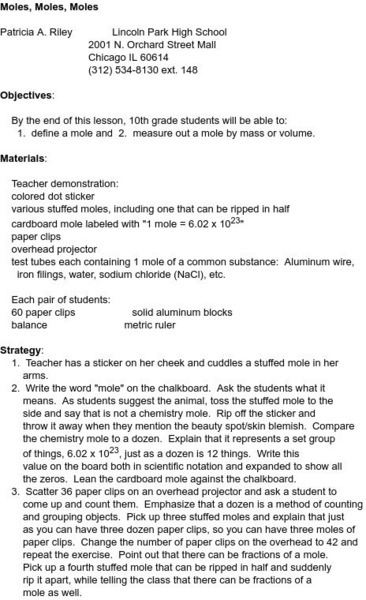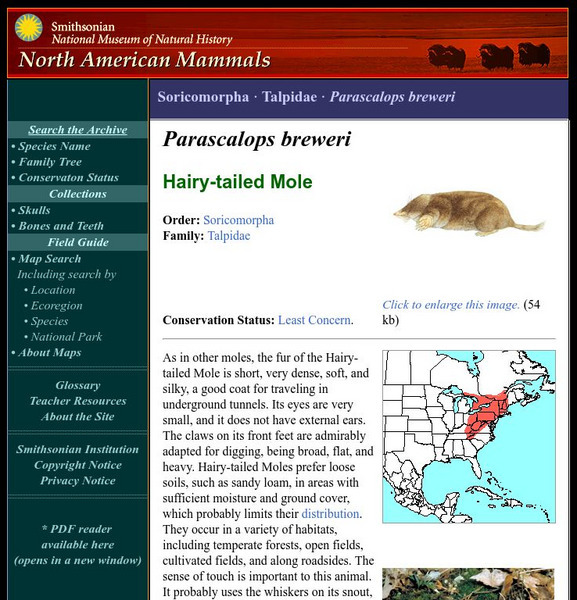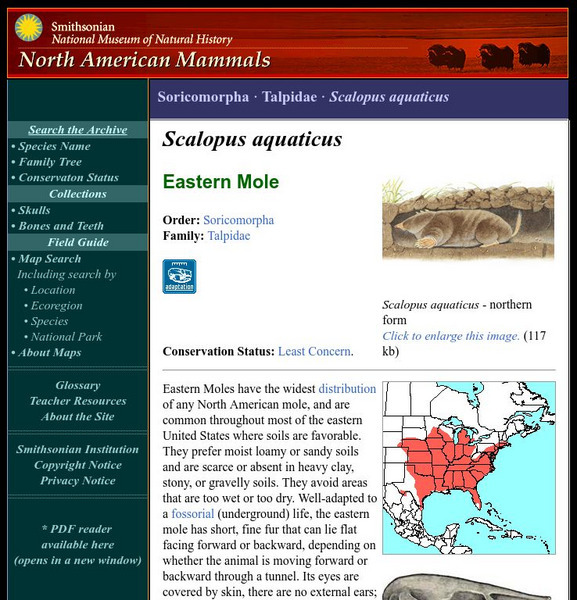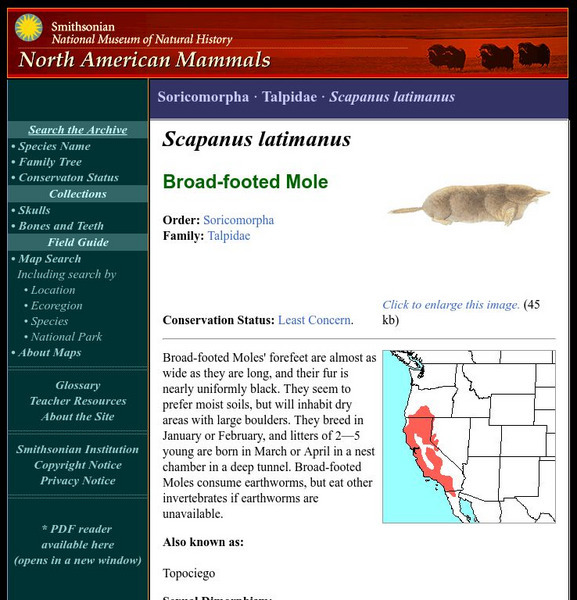California State University
Csudh Project for Chemistry: Elements, Moles, and Masses
Using a Periodic table with a list of atomic weights for reference, practice figuring moles of 103 elements.
Texas Instruments
Texas Instruments: Mole
This activity is designed to assess the comprehension of concepts related to moles.
Utah Education Network
Uen: Writing a Letter Using the Book Mole's Hill
In this lesson, students will engage in writing activities as extensions to Lois Ehlert's book, Mole's Hill. Students will generate soluntions to conflicts in the story, generate ideas for writing letters, write an interactive letter to...
CK-12 Foundation
Ck 12: Mass, Volume, and the Mole
[Free Registration/Login may be required to access all resource tools.] In this learning module, students will learn the significance of using moles in converting between measurements and in understanding how much of something you have.
CK-12 Foundation
Ck 12: Mole Ratios
[Free Registration/Login may be required to access all resource tools.] In this online tutorial students will relate balanced chemical equations to everyday analogies, such as a recipe. They will also define stoichiometry and use mole...
CK-12 Foundation
Ck 12: Mole Ratios
[Free Registration/Login may be required to access all resource tools.] In this learning module, students will learn how to calculate and account for the amounts of reactants and products in a given chemical reaction.
Khan Academy
Khan Academy: The Mole and Avogadro's Number
An explanation the mole (named for molecule) and Avogadro's Number. One mole of a substance is equal to 6.022 times 10 to 23rd power units of that substance (such as atoms, molecules, or ions). The number 6.022 time 10 to 23rd power is...
Sophia Learning
Sophia: Mole as a Quantity
Learn how to define a mole as a number, and estimate the size of a mole of some common objects. [3:18]
Sophia Learning
Sophia: Converting From Particles to Moles
A guided slide show presentation illustrating how to convert from particles to moles.
Smithsonian Institution
Smithsonian National Zoo: Naked Mole Rat
As part of the Amazonia exhibit at the National Zoo, this site highlights various facts and interesting information on the Naked Mole-Rat. In addition to several pictures, the site provides a description and information on habitat, diet,...
Sophia Learning
Sophia: Converting From Grams to Moles: Lesson 2
This lesson demonstrates how to convert from grams to moles. It is 2 of 2 in the series titled "Converting from Grams to Moles."
Sophia Learning
Sophia: Converting From Moles to Grams: Lesson 2
This lesson demonstrates how to convert from moles to grams. It is 2 of 2 in the series titled "Converting from Moles to Grams."
BBC
Bbc: Nature Wildfacts: Naked Mole Rat
This resource provides information about the naked mole rat.
State University of New York
State University of New York: Compounds, Molecules, and the Mole
This simulation explores the relationship between mass, moles, molecules and atoms. Select one of the 6 compounds, set the mass of the compound, and release the scrollbar to calculate.
CK-12 Foundation
Ck 12: Plix Series: Gas Density: Mass, Volume and the Mole
[Free Registration/Login Required] Find out what mathematical function should be performed in order to move from mass to moles and back again. After the activity, answer one multiple choice, challenge question about the topic.
Crescent Public Schools
The Internet Science Room: The Mole Concept
Students explore the concept of a mole and molar mass, and how these values are used in chemistry.
ICT Games
Ict Games: Whack a Mole
Students practice number identification and counting forwards and backwards by whacking the mole with the right number.
Science and Mathematics Initiative for Learning Enhancement (SMILE)
Smile: Moles, Moles, Moles
This is an activity that is designed to introduce students to the concept of the mole.
Other
Celebrate Mole Day at 6:02 on October 23 !!!
A page describing how Mole Day is celebrated at the Massachusetts Academy for Mathematics and Science. Some ideas for celebrations can be found here.
Smithsonian Institution
National Museum of Natural History: American Mammals: Coast Mole
Coast Moles are difficult to distinguish from Townsend's Moles where their ranges overlap in the Pacific Northwest. Both have velvety, dark-gray fur and tiny eyes and ears that are hidden under their fur. Learn more about the Scapanus...
Smithsonian Institution
National Museum of Natural History: American Mammals: Townsend's Mole
The largest moles in North America, weighing in at 100 - 171 grams, Townsend's Moles live only in the lowlands on the western side of the Cascade Mountains, from northwestern California to extreme southwestern British Columbia. One...
Smithsonian Institution
National Museum of Natural History: American Mammals: Hairy Tailed Mole
As in other moles, the fur of the Hairy-tailed Mole is short, very dense, soft, and silky, a good coat for traveling in underground tunnels. Its eyes are very small, and it does not have external ears. Learn more about the Parascalops...
Smithsonian Institution
National Museum of Natural History: American Mammals: Eastern Mole
Eastern Moles have the widest distribution of any North American mole and are common throughout most of the eastern United States where soils are favorable. They prefer moist loamy or sandy soils and are scarce or absent in heavy clay,...
Smithsonian Institution
National Museum of Natural History: American Mammals: Broad Footed Mole
Broad-footed Moles' forefeet are almost as wide as they are long, and their fur is nearly uniformly black. They seem to prefer moist soils, but will inhabit dry areas with large boulders. Learn more about the Scapanus latimanus, more...
Other popular searches
- Molecules
- Molecular Biology
- Atoms and Molecules
- Mole Concept
- Molecular Geometry
- Gumdrop Atoms and Molecules
- Atoms & Molecules
- Compounds and Molecules
- Water Molecules
- Organic Molecules
- Kinetic Molecular Theory
- Atoms Molecules






















